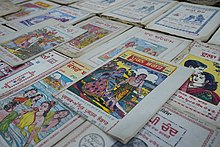Punjabi Qisse
A Punjabi Qissa (Punjabi: پنجابی قصه (Shahmukhi), ਪੰਜਾਬੀ ਕਿੱਸਾ (Gurmukhi); Plural: Qisse) is a tradition of Punjabi language oral story-telling that came to South Asia with the fusion of local people and migrants from the Arabian peninsula and contemporary Iran.[1]

Where Qisse reflect an Islamic and/or Persian heritage of transmitting popular tales of love, valour, honour and moral integrity amongst Muslims, they matured out of the bounds of religion into a more secular form when it reached South Asia and added the existing pre-Islamic Punjabi culture and folklore to its entity.[1]
Etymology
The word Qissa (pronounced Punjabi pronunciation: [kɪssɑː]) is an Arabic word meaning ‘epic legend’ or a ‘folk tale’. It has influenced almost all the languages of South Asia and occurs as a regular common noun in Indo-Aryan languages like Punjabi, Bengali, Gujarati, Urdu and Hindi. If used informally, the word means an ‘interesting tale’ or ‘fable’.
Qisse and the Punjabi culture
The Punjabi language is famous for its rich literature of qisse, most of the which are about love, passion, betrayal, sacrifice, social values and a common man's revolt against a larger system. In the Punjabi tradition, friendship, loyalty, love and ‘qaul’ (verbal agreement or promise) are given utmost importance and most of the stories in the qisse hinge on these critical elements.
Qisse are attributed to have inspired folk music in Punjabi and have added depth and richness to its delivery. These traditions were passed down generations in oral or written forms and were often recited, told as bedtime stories to children or performed musically as folk songs.
Each qissa, if performed, has its unique requirements. A person able to sing or recite one may not necessarily transmit another. The vocal ranges on the musical scale and accurate pauses, if not performed well leaves a performer breathless and unable to continue. Most of the beats used in modern Punjabi music (often misleadingly labelled Bhangra), originated from qissa tradition and recitations in old times. Qisse also boast to be among the best poetry every written in Punjabi.
Poetry based on Qisse
Waris Shah's (1722–1798) qissa of ‘Heer Ranjha’ (formally known as Qissa ‘Heer’) is among the most famous Qisse of all times. The effect of Qisse on Punjabi culture is so strong that even religious leaders and revolutionaries like Guru Gobind Singh and Baba Farid, etc., quoted famous Qissas in their messages. It will not be wrong to say that popularity and nearly divine status of Qisse in Punjabi actually inspired many generations of spiritual leaders and social activists to combine the message of God with teenage love tales. This gave rise to what is known as the Sufi movement in Punjab region.
The most popular writer/poet to have written Punjabi Sufi Qisse was Bulleh Shah (c.1680-1758). So popular are his Kalams (poems) that he is frequently quoted by young and old alike with same respect and on matters of both love and God. In recent times, South Asian singer's have sported these folklores on their albums, for instance, the most famous folklore duo like Kuldeep Manak and Dev Tharike Wala wrote and sang about almost every Qissa, and Recently, Rabbi by (Rabbi Shergill) contained ‘Bulla Ki Jaana Main Kaun’, translated in English as ‘I know not who I am’, written by Bulleh Shah. A few years back another singer, (Harbhajan Maan), a Canada-based Punjabi singer rejuvenated the story of ‘Mirza Sahiban’, a work by Peelu. Daim Iqbal Daim from Mandi Bahauddin District, Pakistan also wrote many qissas in Punjabi language like Mirza Sahiban, Laila Majnu, Sohni Mahiwal, Bilal Biti etc. Daim got popularity by writing "Shah Nama Karbla" and "Kambal Posh".
Notable Qisse
Most of the Punjabi qisse were written by Muslim poets who wandered the land. The oldest were usually scripted in Urdu. Some of the most popular qisse are listed below.
- ‘Mirza Sahiba’ by Peelu
- ‘Heer Ranjha’ by Waris Shah
- ‘Sohni Mahiwal’ by Fazal shah Syyed
- ‘Sassi Punnun’ by Hasham Shah /
- ‘Sucha Singh Soorma’
- ‘Jeona Morh by Bhagwan Singh
- ‘Shirin Farhad’
- ‘Pooran Bhagat by Kadaryaar
- ‘Kehar Singh Ram Kaur’
- ‘Sham Kaur, Sham Singh, Sham Lal’
- ‘Dhol Sammi’
- ‘Yusuf and Zulaikha by Hafiz Barkhurdar
- ‘Laila Majnu’
- ‘Kaulan’
- ‘Dulla Bhatti’
- ‘Manu Guggu’
- ‘Ustaad Harman’
- ‘Jatt Parmz’
See also
References
- Mir, Farina. "Representations of Piety and Community in Late-nineteenth-century Punjabi Qisse". Columbia University. Retrieved 2008-07-04.
- Mir, Farina (May 2006). "Genre and Devotion in Punjabi Popular Narratives: Rethinking Cultural and Religious Syncretism". Comparative Studies in Society and History. Cambridge University Press. 48 (3): 727–758. doi:10.1017/S0010417506000284.
External links
- ApnaOrg offers one of the most reliable but largely incomplete list of Punjabi literature and music.
- Punjabi People & Old Stories Network of Punjabi People

